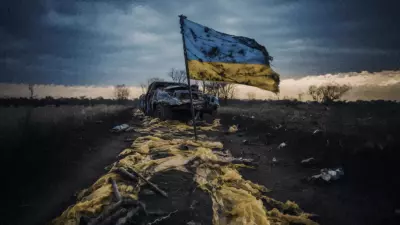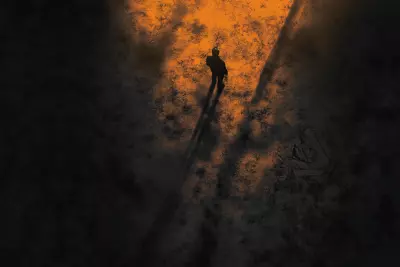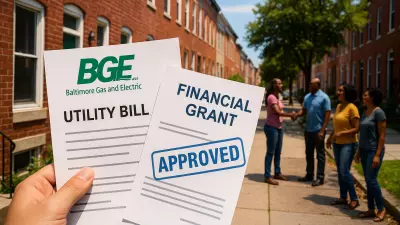Russian President Vladimir Putin has long maintained that the territories once controlled by the former Soviet Union are the rightful claim of modern-day Russia, a belief that imperils not only Ukraine but several other nations.

[Editor’s Note: The following is another insightful editorial from The Ukrainians Media, a Postindustrial publishing partners we’re proud to support.]
President Donald Trump recently spent over two hours on the phone with his Russian counterpart, Vladimir Putin.
Like the businessman he claims to be, Trump emerged from the call claiming he brokered a 30-day ceasefire between Russia and Ukraine.
And like a seasoned imperialist, Russian President Putin broke the terms within hours. Russia launched 40 missiles across Eastern Ukraine, hitting both a hospital and an energy substation.
The terms between the extravagant businessman and the career spy have cooled significantly since then. Last week, Russia released a statement claiming that the U.S. still hadn’t answered several critical questions regarding its proposed truce.
Already, the two countries are bickering and bashing their heads. With this nascent volatility, many Ukrainians wonder: What will happen if two ambitious leaders of nuclear states finally collide?
Enter America’s leading, rightwing voice
One person who may help us understand the two presidents is American media personality Tucker Carlson.
A strong supporter of Trump’s policies, he clearly summarized the main points of the new U.S. president’s foreign policy in his late January interview with British journalist Piers Morgan.
In the interview, Carlson voiced a range of dismissive opinions about Ukraine and NATO. At one moment, he called Zelenskyy a dictator; at another, he accused him of oppressing Christians and Russian speakers—all while presenting Russia as a potential ally in the rivalry with China.
The massive and economically powerful China., which is pushing the U.S. out of global markets, is Trump’s primary competitor.
The U.S.S.R. once posed a similar economic challenge to the United States.
However, Russia is significantly smaller these days, though it still holds the largest territory in the world. This deeply worries Putin.
Living in Ukraine, it’s not difficult to decipher the Russian president’s intentions in this war—in fact, they are clearly visible to the naked eye. After all, Russia has never hidden them.
Back in 2005, Putin called the collapse of the U.S.S.R. “the greatest geopolitical catastrophe of the century.” For him, the Soviet Union was genuine “historic Russia.”
In other words, that vast state—which included not only modern-day Russia but also 14 other occupied republics and whose troops controlled the eastern half of Europe—is, for the Russian leader, the rightful territory of his homeland, which he’s trying to restore in every way.
This became even more apparent when Tucker Carlson flew to Moscow to interview Putin in February of 2024. It was the first time since the beginning of Russia’s full-scale invasion of Ukraine that a Western journalist had the opportunity to speak with Putin one-on-one.
The very fact that he agreed to the interview was striking: it gave him a rare chance to speak directly to the audiences of democratic nations that support Ukraine, not Russia.
What rationale would he offer for his warmongering?
Would he accuse the West and NATO of threatening Russia’s security, appealing to audiences in postcolonial nations of the Global South? Or perhaps he would target liberal governments, claiming they were dragging their countries into a dangerous war with the Russian Federation. That narrative might have resonated with some more conservative Western listeners.

What choice would he make?
Putin chose neither.
Instead, he launched into a lecture on medieval history, “enlightening” Tucker Carlson about the rulers of ancient Kyiv—as if that somehow justified Russia’s invasion of Ukraine. This rambling monologue was widely seen as bizarre, though for Putin, it was business as usual.
It was a textbook example of imperialist rhetoric: an attempt to portray Ukraine as a non-existent state to which Russia holds historical claims. You might have heard similar arguments in the imperial capitals of the 18th century—but not on primetime TV in 2024.
Putin’s interview may have gone poorly, but it did nothing to change the fact that the Russian war to conquer Ukraine pressed on.
But Trump decided to change that. For several months, he has been trying to organize peace talks between Russia and Ukraine, but with no results so far.
The reason is fairly simple: polls in both countries show that neither Ukrainians nor Russians are ready to accept each other’s demands, and both nations are still willing to fight.
Earlier this year, Trump pursued a complete change in policy from his predecessor, Joe Biden.
During a meeting at the White House, Trump pressured Ukrainian President Volodymyr Zelenskyy to compromise with Russia, the aggressor.
And why exactly?
No one can know for certain what exactly motivates his actions. Perhaps Trump is genuinely trying to fulfill his promise of ending the war—and believes this is the only way to do so without acting like President Biden, that is, by pressuring Russia and supporting Ukraine.
Or he may be hoping to drive a wedge between Russia and China, which he stated would be his priority during an interview with Tucker Carlson in October of 2024.
Whatever the case, Putin isn’t ready to compromise and wants to continue his conquest of Ukraine. Negotiations are ongoing, but the Russian president is simply buying time by continually introducing new conditions for a ceasefire. It’s a strategic move—if Putin outright refuses Trump’s peace offer, it might push the U.S. to resume aid to Ukraine.

Playing Putin’s favorite game
This kind of game with negotiations is one of the Russian president’s favorite tactics. As a former intelligence officer, Putin sees every situation as an opportunity for a special operation—even calling the war against Ukraine precisely that: a “special military operation.” Manipulating agreements is just another example of this. Putin’s portfolio includes a whole series of manipulations of other countries, in which Russia presented itself as a neutral country but, through the power of its intimidation, kept foreign governments under its control.
When Putin rose to power in the late 1990s, Russia was still recovering from the collapse of the communist system and had just lost the war in Chechnya—a small republic in the northern Caucasus Mountains. In 1996, Moscow effectively recognized the independent Chechen Republic. As time showed, that was only a temporary decision. Shortly before Putin took power, a series of apartment bombings occurred in Russian cities. The Kremlin blamed Chechen fighters and used the attacks as justification for launching the Second Chechen War and establishing a repressive security apparatus. The real circumstances behind the bombings remain unclear. One Russian intelligence officer who fled to the UK—Alexander Litvinenko—blamed the FSB. Later, Litvinenko was murdered with poisonous and radioactive polonium.
In Moldova, Russia maintained troops in the unrecognized Transnistrian Republic, a small separatist territory Moscow used to exert influence over the young country.
In Nagorno-Karabakh—a region of Azerbaijan populated by Armenians—the Kremlin stationed peacekeepers, exploiting the Armenian-Azerbaijani conflict to maintain influence over both nations.
At first, Russia supported the Armenians, forming a separatist enclave within Azerbaijan. Later, it switched sides when Armenia underwent a democratic revolution, and Azerbaijan’s hereditary dictatorship under the Aliyev clan strengthened. Today, almost no Armenians remain in Nagorno-Karabakh—they fled during an Azerbaijani offensive, which unfolded under the silent watch of Russian peacekeepers.
Putin also played the deal game in Georgia, which Russia invaded in 2008. That Caucasian country had two frozen conflicts with autonomous regions since the 1990s. Moscow declared itself the protector of these regions and later recognized them as independent states. Russia then invaded Georgia when it tried to regain control of its internationally recognized territories. Today, Georgia is ruled by a pro-Russian government, as many Georgians fear that overly pro-Western policies could trigger another war with Moscow.
A precedent for gaining power
Through such deals, Russia has also gained near-total control over Belarus. That nation’s dictator, Alexander Lukashenko, had agreed with Putin’s predecessor, President Yeltsin, to form the so-called “Union State of Russia and Belarus.” Lukashenko likely hoped for a high position in the new union. But Putin outmaneuvered him: the longer Lukashenko clung to power, the more dependent he became on Moscow. When democratic protests erupted in Belarus in 2020, Kremlin support helped the self-proclaimed president crush the demonstrations and launch a wave of repression. Now, Russia uses Belarus as its own territory—even launching attacks on Ukraine from there.
Russia has long tried to exact Putin’s same use of strategic deception and coercive diplomacy over Ukraine. When diplomacy alone proved insufficient to seize Ukraine, Russia moved on to more radical action. In 2014, when democratic protests in Kyiv ousted the corrupt, pro-Russian president Viktor Yanukovych, Kremlin troops took advantage of Ukraine’s post-revolution vulnerability, occupying Crimea and starting the war in the country’s east. Putin claimed Ukraine was run by Nazis who threatened Russian-speaking citizens—only Kremlin troops could protect them.
At that time, most Ukrainians had a positive view of Russia, according to polls. Most also opposed NATO membership (though they supported EU integration). While the world tried to make sense of the situation, Moscow occupied part of Ukraine and secured a ceasefire.
That ceasefire agreed to in the Minsk negotiations lasted from 2015. Moscow used the time to build up its forces and pressure Kyiv. When Ukrainians elected President Volodymyr Zelenskyy in 2019, one of his first moves was to resume negotiations with Moscow. But Putin wasn’t looking for compromise—only Ukrainian surrender. When he couldn’t force the new president to capitulate, Russia launched a full-scale invasion in 2022.
Today, Russia once again has someone to negotiate with. Putin still demands Ukraine’s complete surrender, or at least that Kyiv abandon plans to join international alliances and reduce its army
In other words, give up its ability to defend itself in exchange for a promise of peace. No Ukrainian wants to agree to this because how could anyone guarantee that Moscow won’t rebuild its army and launch another attack in a few years?
Because of this, the Trump administration is trying new approaches with Putin while he keeps inventing new excuses to avoid peace. All previous manipulations have worked to Putin’s advantage: He’s stayed in power and managed to force several neighboring countries to yield to Russia’s will. Now, Putin is trying to do something similar with the U.S.
Trump is a man of great ambition, leading the immense power of the United States. At present, he views Russia as a potential partner. But what will happen when he finally realizes that Putin has no intention of yielding to his demands?
Translated from Ukrainian by Editor Iryna Humenyuk
Please consider supporting The Ukrainians Media on Patreon to help protect Ukrainian independent journalism.







